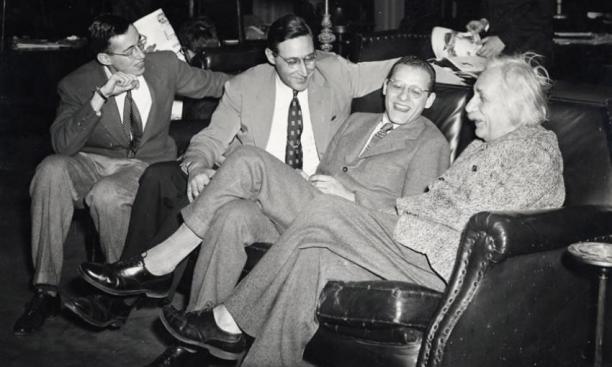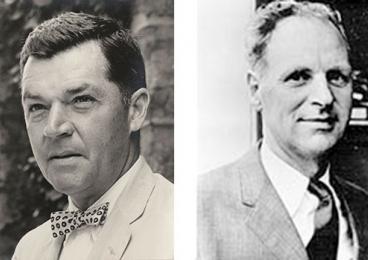
You can talk, talk, talk, bicker, bicker, bicker.
You can talk all you wanna, but it’s different than it was.
— The Music Man, 1957
Last time, we noted that Princeton began to hire and admit Jewish men under president Woodrow Wilson. We noted the first two Jewish honorary-degree recipients, Rufus Isaacs (1918) and Albert Einstein (1921). We also told the story of Henry Morgenthau III ’39, preppie athletic scion of an honored immigrant family who was hosed in bicker in 1937, clearly because he was “Hebrew.” What happened?
If the discussion (food fight?) of foreign relations in today’s presidential campaign makes you nervous, you would have been despondent in 1920. The trauma of World War I, America’s first full immersion in global geopolitics, affected significant aspects of its culture for the next decade and beyond. The backlash was rampant xenophobia, bluntly reflected in the election campaign slogan of the victorious nonentity Warren G. Harding: “Return to normalcy.” Warming up by torpedoing the Treaty of Versailles, he died after managing to cement his record as the worst president of the 20th century in only two and a half years. This included the “Emergency Quota Act” of 1921, a hybrid of anti-immigrant bias plus the pseudoscience of eugenics, rampant among the American intelligentsia of the day, and future deadly plaything of folks such as Hitler. Reinforced by the Immigration Act of 1924, this structure formulaically slowed entry of Eastern and Southern Europeans (affecting many Jews) and Africans into the United States to a trickle, while banning Asians and Arabs completely. In 1920, 190,000 Jews emigrated here; by 1924, it was 7,000, actually fewer than the number of those who left.
Perversely, at that moment the pressure from a sharply increasing number of college applicants, plus the historical concern for a predominantly residential campus, drove Princeton to limit class size and construct a formalized admission procedure for the first time. In the aura of the increasing national biases, the old WASP power structure of the elite Eastern universities (who all were similarly instituting more formal applications) was being shaken by an upsurge in “minority” applicants; Columbia’s student body had become about 40 percent Jewish almost overnight, and administrators elsewhere were petrified this trend would disaffect alumni and (somehow) cause ruin. Then Princeton’s new admission administration was handed in 1922 to a professor, ironically not an alumnus, named Radcliffe Heermance. The number of Jews matriculating had been 25 in 1922, but only two years later there were 13, and by 1931 five. The number would not rise above 25 again until 1945.
Heermance approved every admit personally and created a wide range of practices that gained currency in other American admission offices. Most of them, in the 1920s, served to disadvantage Jewish applicants. Students were given separate evaluations on academics and “character,” some vague sort of quotient that could be subjectively applied to each man. It emphatically was, and so the “well-rounded boy,” cultured, gregarious and not necessarily brilliant, was triumphant. Alumni were aggressively encouraged to become an organized part of the recruitment process; as the vast majority were preppie club veterans, they tended in the protectionist ’20s to value those who would be similar. If an old family friend or uncle was a Princeton alumnus (and so almost certainly not Jewish), a shining letter of recommendation would be a virtual key to admission. Alumni sons who were not under arrest were shoo-ins. Under the rubric of diversifying the student body, the admission office reached out to the South, Midwest. and West where there were – what a surprise – very few Jews. For 20 years, the proportion of entering Jewish men – you were required to state your religion on your application form – remained at 3 percent, the exact percentage as in the United States (although certainly much less than the proportion within 200 miles of Princeton).
But the new admission office and the alumni were only two-thirds of the impediment; the third we witnessed last time through the story of Henry Morgenthau III ’39. There was no tactic Heermance could employ to deny admission to the Deerfield son of the U.S. treasury secretary, but no eating club could be forced to accept him — and none did. Given the sort of reputation Princeton developed among teenagers through such bicker idiocy, it’s astounding any Jews applied at all. The hegemony of the clubs was Heermance’s secret weapon.
We’ve spoken before of 1940, when Bob Goheen ’40 *48 as a senior and chair of the Inter-Club Council began trying to spearhead bicker reforms, but it wasn’t until after the end of World War II that the world of Heermance (still in charge after 24 years in 1946) rapidly began to erode. Alumni involved in admissions now were cognizant of promising students in their towns from many backgrounds, and began to push for more public-school and minority admissions of all sorts. Admitted in 1947, the Class of ’51 was 3 percent Jewish, with fewer Jews than its parent Class of ’26 (24 vs. 25). But in 1948 the Class of ’52 – today the second-leading donors of all time to Annual Giving – had 54 Jewish classmates, almost 7 percent. And then in 1950 came the denouement: The State of New Jersey made it illegal to ask an applicant to state his religion, the Class of ’52 demanded 100 percent bicker and the clubs capitulated, and after 28 years Heermance retired.
The pace of change quickened when Goheen became the youngest Princeton president in two centuries in 1957, but his administration began with the grotesque last spasm of the clubs’ long-standing snobbery – dirty bicker in 1958. Check out Paul Rochmis ’60’s moving PAW interview or Geoffrey Woolf ’60’s novel The Final Club if you want a case study in institutional pettiness, which showed how little the Street had done to address its weaknesses since the hatchet job on Henry Morgenthau in 1937. The new president’s response was both tactical – the next February he publicly stated the clubs would probably blow it again, so of course they didn’t dare – and strategic. Two months after dirty bicker, Princeton’s first majority public high school class was admitted. By 1962, Princeton was about 15 percent Jewish.
The “well-rounded boy” came under direct attack in 1960 when a faculty study decried the idea as anti-intellectual and degrading the student body; within two years, the administration was publicly promoting the contrasting concept of “the well-rounded class” with plenty of room for home-schooled piano virtuosi and 12-year-old polymaths as well as football captains from Exeter. The main voice for this idea was Alden Dunham ’53, whose brief tenure as admission director (1962-66) involved the first serious recruitment of black students, with the aid of Carl Fields, and who first attached to the well-rounded class the word “diversity.” Where it firmly remains today.
The stance of Princeton’s leaders on anti-Semitism, for anyone who somehow hadn’t gotten the memo, was publicly clarified in April 1964. In reaction to a Whig-Clio exhibit honoring the 20th anniversary of the Warsaw Ghetto uprising, an undergraduate wrote a letter to the Prince belittling the revolt’s importance and denigrating overall Jewish political motives in the process. Two days later, a response was published, hoping the student “will learn from it that the suffering of any man anywhere is a matter of deep concern to each one of us.” It was signed simply “Ernest Gordon,” the dean of the Chapel who had been held captive at the horrific River Kwai POW camp in World War II, and who had invited Rev. Dr. Martin Luther King Jr. to preach in the Chapel in 1960 (much to the grumbling of some alumni). Immediately above his letter was another response, making it clear that (despite the student’s absolute right to express his opinion) “the letter in question patently speaks from blind prejudice and is utterly foreign both to the intellectual and the moral ideals of this university.” It was signed “Robert F. Goheen.”

Two months later, Harold Shapiro *64 received his Ph.D. in the economics department. Twenty-four years afterward, he would become the first Jewish president of Princeton.
The clubs, always the most closed, problematic part of the Old Princeton, got their comeuppance last, in 1968. The story of Wilson College and Stevenson Hall we’ve told before; the selective clubs’ membership dropped from over 90 percent of the upper classes to 70 percent in an instant. By the time the smoke cleared, not only were Princeton men far more diverse, with Jews, blacks, and other minorities spread far wider throughout the University, but they were accompanied by Princeton women.
When I first heard about this month’s Jewish alumni conference, I was very pleased – preceding conferences centering on African-American, women, LGBTA, and Asian and Asian American alumni have been highly successful and a boon to Princeton, and celebrating at Princeton’s centerpiece Center for Jewish Life is a great idea. But while considering that, it occurred to me that, although I knew my roommate was Jewish (his father was a refugee from Hitler’s Austria), there are literally dozens of classmates, including friends from WPRB, the Glee Club, Stevenson Hall, the Prince, wherever, who might very well be Jewish too (or Buddhist, or Muslim, or Druid, I guess) and I didn’t care then, and I don’t care now. What the hell were the decades of institutional paranoia really about?
As we’ve said many times this year, it’s dangerous to judge people in the past by current mores, and perhaps for some reason I would have been even more obnoxious and obstructionist than Radcliffe Heermance if put in his place. But I hope not. What I can tell you is that Henry Morgenthau III ’39 is a highly honored member of my profession, the media, with Peabody and Emmy awards, and an accomplished author. I would have enjoyed knowing him in 1968, and I fervently hope I would have enjoyed it in 1937.
Henry, l’chaim!
